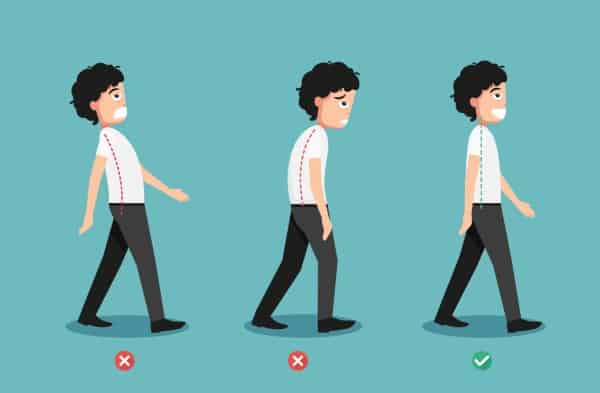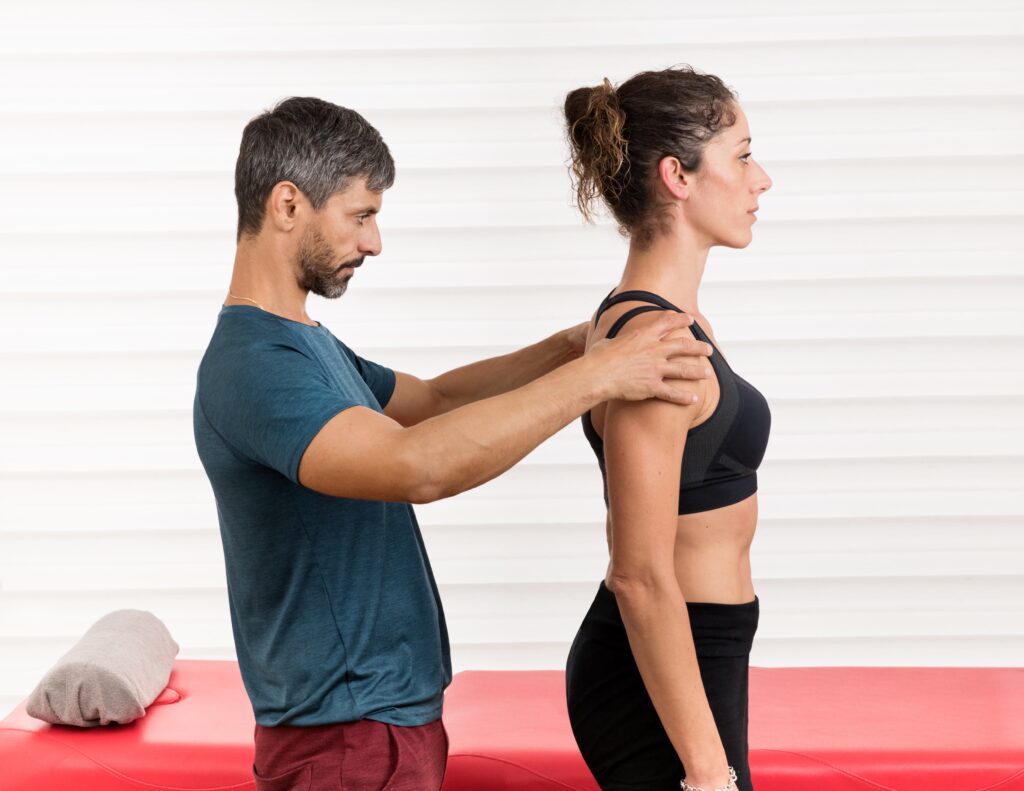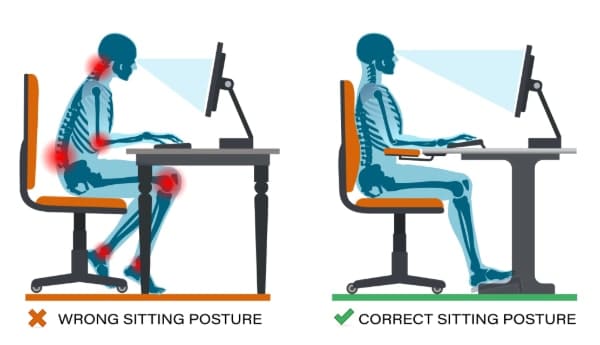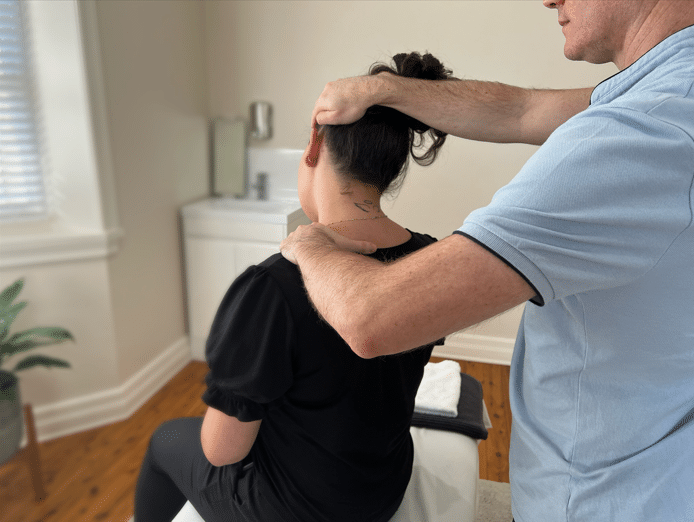- 02 9712 1736
- [email protected]
- 212 Great North Road, Five Dock, NSW 2046
- Open 7 days a week
Your poor posture can be the reason for the discomfort that you feel in your back. And it can lead to long-term back issues if left unaddressed. Poor posture can negatively affect your joint function and health, increase pressure on your discs, and cause chronic muscle fatigue and tightness. Read on as we break down the common issues that most people have with their posture and provide you with tips to help improve your posture.

Poor posture can negatively affect your spinal health, and result in neck pain, back pain, etc. By poor posture, we do not mean standing or sitting incorrectly for a few minutes. Back pain is a result of long term, habitual poor posture that has been left unaddressed and allowed to progressively get worse. Sustained poor posture puts significant stress on the spine – the muscles, joints, and ligaments – leading to functional compensations, degenerative changes, and finally, pain and discomfort.
Muscle fatigue, tightness, and spasms are common consequences of poor posture. Sustaining poor posture for long periods of time places a lot of unnatural stress on your body, including your muscles, causing muscle fatigue and tightness. The stress you place on your body as you maintain poor posture for extended lengths of time forces some muscles to work harder than normal, causing discomfort and pain over time.
Prolonged poor posture can lead to joint degeneration. Uneven joint loading as a result of poor posture causes irregular wear on the joints, which can eventuate in joint degeneration and subsequent pain. Degenerating joints become more prone to inflammation, which can further complicate back pain issues.
Looking down at your phone, sitting at a desk in front of the computer, and lounging on a couch are all seemingly harmless activities that you may be spending a lot of time doing everyday. But did you know that these are also the activities that often results in the development of poor posture. Let us take a look at each of these activities and expand on the postural issues that they are linked with.
This is a postural issue that we are seeing more often in recent years and is caused by spending too much time looking down at your phone. This condition puts a lot of strain on the neck, often leading to neck pain and discomfort in the upper back. When we have our head and neck bent forward, the weight of our head shifts forward, away from the body, significantly increasing the effective weight on the cervical spine, and causing the strain on your neck and upper back.


Many of us spend hours seated at a desk or in front of a computer, often without taking breaks to stand or stretch. This places a lot of unnatural stress on the body, especially your lower back. Muscle fatigue from prolonged sitting can cause deconditioning and weakness in the muscles that stabilise your spine, increasing your risk of injury. Prolonged sitting can also increase pressure on spinal discs, potentially leading to disc herniation or bulging discs.
If you notice that you have rounded shoulders, you are not alone. This is another common postural issue that can contribute to back pain. This posture is often a result of habitual slouching, naturally occurring as your chest muscles becomes progressively tighter and shorter, pulling your shoulders forward. Rounded shoulders also cause stiffness and decreased upper back flexibility, leading to pain and discomfort between the shoulder blades over time.

Poor posture can have a profound impact on spinal health. Specific postural problems such as slouching and forward head posture significantly compromise back health. Prolonged inactivity, as in the case with extended period of sitting, can lead to reduced flexibility and muscle endurance due to the effects of deconditioning, increasing the risk of back pain.
Poor posture often disrupts the natural curvature and alignment of the spine affecting joint function and health. Uneven loading on the joints of your spine due to changes to the natural curvature of the spine can lead to restricted movement, early degenerative changes in your spine, and eventually pain and discomfort.
Improper posture can result in excessive unnatural loading of the spinal discs, raising the risk of conditions such as herniated or bulging discs. Extended period of sitting with poor ergonomics, for instance, significantly raises the risk of disc herniation as the spinal stabilising muscle deconditions from the inactivity and as a result of long term uneven loading of the spinal discs. Chronic poor posture can cause joint inflammation and degeneration.
Poor posture can also lead to nerve compression, causing pain and numbness. Poor posture can cause narrowing of spaces where your nerves travel. Compression of nerves can result in symptoms such as radiating pain, numbness, or tingling sensations.
Improving posture is beneficial regardless of age and can prevent pain while boosting overall well-being. Using a mirror to check your alignment and correcting slouching can help maintain good posture.
Here are some specific tips to improve posture and alleviate back pain.

Your core muscles play a very important role in creating spinal stability. Improving your core strength and doing exercises like planks, bridges, and dead bug can significantly help alleviate back pain. Activities like yoga, Pilates, and tai chi are also recommended for improving back strength and flexibility.
Ergonomic adjustments promote good posture when you are sitting. Uncomfortable chairs lacking in back support, improperly positioned screens, and cluttered desks can often force you to adopt unnatural postures, which can become habitual if repeated often enough. If you relate to this, make the changes you need to your desk setup to make it easier for yourself to maintain good posture.


Regular movement and stretching relieve back pressure and enhance flexibility. Short walks throughout the day can be all you need to maintain mobility and prevent stiffness and pain. Stretches for the chest, hamstrings, and neck can enhance also be beneficial to maintain flexibility and mobility in your spine.
There are several common misconceptions surrounding the topic of posture and back pain that we think require clarification. Here are some detailed explanations addressing these misconceptions.
Good posture reduces the risk of developing back pain but doesn’t guarantee prevention, as genetics and lifestyle also play significant roles. Conditions such as arthritis or injuries can cause back pain independent of one’s posture.
It is also important to know that there is no single ideal posture that prevents back pain. Focusing on an ideal posture can cause unnecessary fear of movement, increasing pain and disability.
Bad posture can contribute to back pain for all the reasons we have expanded on in this post. However, not all back pain is caused by bad posture. You can have back pain for a multitude of other reasons too. Back pain can arise from a variety of factors, including stress, injury, and underlying health conditions, rather than solely from poor posture.
Recognizing that back pain stems from various factors—physical, ergonomic, and lifestyle—is crucial. Maintaining a holistic approach to back health is crucial for alleviating pain.
Poor posture is a significant contributor to back pain and spinal health issues. Addressing specific postural issues like prolonged sitting, text neck, and rounded shoulders can prevent further complications. Strengthening core muscles, making ergonomic adjustments, and incorporating regular movement and stretching into your routine are essential for maintaining a healthy spine.
By understanding the link between posture and back health, you can take proactive steps to improve your well-being. Remember, good posture is not about perfection but about finding a balance that supports your body and reduces pain. Stand tall, move often, and keep your spine healthy.

Forest Lodge, Annandale, Glebe, Leichhardt, Balmain, Haberfield, Canada Bay, Rozelle, Rodd Point, Wareemba, Stanmore, Petersham, Lilyfield, Hunters Hill, Enfield, Cabarita, Mortlake, Rhodes, Burwood Heights, Birchgrove, Gladesville, Huntleys Point, Abbotsford, Ashfield, Croydon Park, Croydon, Chiswick, Russell Lea, Burwood, Strathfield, Concord, Drummoyne, North Strathfield, Liberty Grove, Dulwich Hill, Lewisham, Camperdown, Ashbury, Homebush, Homebush West, Woolwich, Henley, Summer Hill, Sydney Olympic Park
About
Five Dock Osteopathic & Chiropractic is located in Canada Bay, in Sydney’s Inner West. Servicing suburbs including Burwood, Croydon, Drummoyne, Five Dock, Haberfield, Concord, Abbotsford, Chiswick, Leichhardt, Wareemba, Russell Lea, Summer Hill, Strathfield.
Clinic hours
Monday, Tuesday, Thursday 7AM – 7PM
Wednesday, Friday 7AM – 6PM
Saturday 7AM – 2PM
Sunday 8AM – 2PM
Contact details